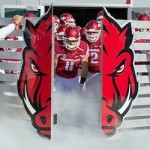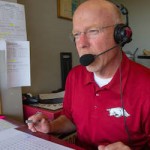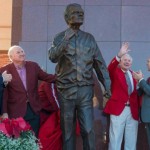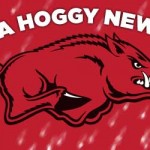Editor’s note: This is the third in a four-part series about retiring Arkansas Razorback emeritus athletic director Frank Broyles, whose last official day at the UA was June 30. Part two is here.
 As long as Arkansas Razorback athletic history is debated, the question will remain: Did Frank Broyles stay too long in the athletic director’s chair?
As long as Arkansas Razorback athletic history is debated, the question will remain: Did Frank Broyles stay too long in the athletic director’s chair?
Broyles would serve as athletic director for 35 years before giving up the role to current Arkansas AD Jeff Long. Broyles’ last decade in the job was full of missteps, sometimes attributable to bad advice from other officials who wanted similar power.
But Broyles’ first two decades seemed blessed, with the exception of a couple of personality squabbles with coaches, and it continued right through Broyles’ guiding Arkansas away from being the only non-Texas school in the Southwest Conference and into the Southeastern Conference, where Broyles himself had been a star athlete for then-league member Georgia Tech in the 1940s.
Let’s start with the beginning in looking at Broyles’ career as athletic director.
Broyles, then head football coach for the Hogs and just 48, took over for George Cole as AD in 1973, though it’s hard to believe anyone but Frank wasn’t calling the shots after his boss, John Barnhill, became too ill and stepped down in the late 1960s. And really, at that time, football was all that mattered at Arkansas in the late 1960s and early 1970s.
Broyles combined the AD and coach roles for three years — he was in the throes of rebuilding Arkansas football to national prominence during his last five seasons as head coach, and blending both positions had to be grueling. Broyles, having noted the rise in popularity of college basketball thanks to TV, had also decided that Razorback basketball needed to be on a prominent level and hired Eddie Sutton from Creighton to guide that effort.
Broyles’ judgment of people was brilliant at this time. How else could a former shop teacher from Greenland be handed the cross country program, and then the entire track and field program, the way Broyles turned it over to John McDonnell, and then Arkansas become a powerhouse in the sport? McDonnell was to track and field as Indiana’s incomparable John Councilman was to NCAA swimming, eventually winning 42 national championships.
Broyles didn’t hire Norm DeBriyn, Cole did, but Broyles gave the baseball coach all he needed to contend with the dominant Texas teams. Golf and tennis also got Broyles’ full attention — golf, of course, since the Hogs’ football coach was pretty good at it himself.
Broyles’ political gifts — truly, if you had met the man in the 1970s, he had the personal magnetism of a governor or senator — were put to use in cajoiling the Arkansas legislature into a one-time project, providing financial support for a then state-of-the-art athletic complex that bears Broyles’ name (so does the field now at Donald W. Reynolds Razorback Stadium).
Broyles simply told the Arkansas legislature, “Either you help us compete with the other teams in the Southwest Conference, or we need to join the [Arkansas Intercollegiate Conference].”
After that, and with his right-hand man, Wilson Matthews, continuing to build what would become the Razorback Foundation, Arkansas never had to lean on the state’s taxpayers again to stay competitive. The fan base provided all the money while Broyles was in charge and, for the next generation, it’s a system that worked perfectly.
Broyles wasn’t the same coach he had been in the 1960s, though, and he was certain of it by midseason 1976, when he decided to retire from the sideline. He made it publicly known as Arkansas prepared for its season finale at Texas in December.
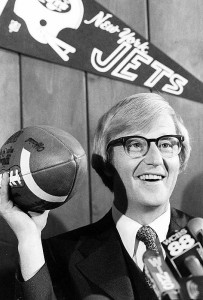 Two weeks later, his genius for picking the right man was on display again. He convinced Lou Holtz to become his successor, even before Holtz’ first edition of New York Jets had ended the season.
Two weeks later, his genius for picking the right man was on display again. He convinced Lou Holtz to become his successor, even before Holtz’ first edition of New York Jets had ended the season.
(This scenario would coincidentally play out again in 2007, when Jeff Long hired Bobby Petrino away from the Atlanta Falcons in his first year there, with three games left to play.)
Broyles’ last staff, which included future Miami Hurricane and Dallas Cowboys coach Jimmy Johnson, had recruited Arkansas back to competitiveness — Broyles enjoyed a last Cotton Bowl win over Georgia on Jan. 1, 1975, in fact, and a program-defining upset of eventual national champ Southern Cal in 1974, as the talent fell into place. Holtz was the beneficiary, using his split-back veer offense and Monte Kiffin’s defensive genius to forge an 11-1 season and No. 3 national ranking when the “experts” had predicted a .500 record for the Hogs in 1977. The capper was the 31-6 romp over Oklahoma in the 1978 Orange Bowl.
Holtz kept Arkansas humming, going 10-2 in 1979 and losing to No. 1 Alabama in the Sugar Bowl, and the wise-cracking comedian of a coach never had a losing season in his seven in Fayetteville.
But Holtz’s recruiting, particularly at a time when Arkansas would produce maybe its best talent in a two-year period ever, had ebbed and Holtz had lost the respect of some influential in-state coaches. Yes, Holtz had also appeared in advertising for racist North Carolina Senator Jesse Helms, but that was overplayed. What really concerned Broyles was the recruiting and the future of the program, as well as Holtz’s mercurial manner. So after a 6-5 year when the coach threatened yet again in a December meeting that maybe he should resign, Broyles agreed with him.
He had his replacement picked out: Air Force head coach Ken Hatfield, who had taken a moribund program (Hatfield had been on Bill Parcells’ staff there when Parcells left for the NFL after a 2-9 season) and implemented an offense he called the “flexbone” — a wishbone-T look that included flexing the backs outside for passing. Broyles saw Hatfield lead Air Force to an upset over Notre Dame and saw an inspirational, innovative leader.
Broyles had been able to see this because, after his retirement as coach, ABC began using him as a color commentator on college football games. By 1983, he was the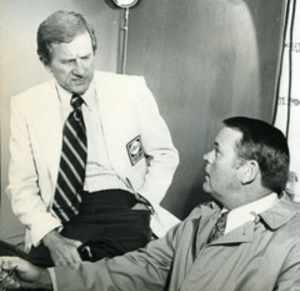 No. 1 analyst alongside folksy play-by-play man Keith Jackson, and they made a perfect pairing. Broyles, as he had done as head football coach, acted as the CEO athletic director and hired all the right people to make the Arkansas machine run like clockwork, while he could be away on game days appearing on TV. No one minded; Broyles had always had a way with the TV people dating back to his coaching days, and in 1969 his relationship with ABC’s Roone Arledge led to a first-time-ever three TV appearances for both Arkansas and Texas in one season, including the Dec. 6 “Big Shootout” in Fayetteville.
No. 1 analyst alongside folksy play-by-play man Keith Jackson, and they made a perfect pairing. Broyles, as he had done as head football coach, acted as the CEO athletic director and hired all the right people to make the Arkansas machine run like clockwork, while he could be away on game days appearing on TV. No one minded; Broyles had always had a way with the TV people dating back to his coaching days, and in 1969 his relationship with ABC’s Roone Arledge led to a first-time-ever three TV appearances for both Arkansas and Texas in one season, including the Dec. 6 “Big Shootout” in Fayetteville.
As difficult as it might be for SEC and Arkansas fans to imagine, being 30-40 years removed from it, Arkansas was a program that mattered nationally during Broyles’ tenure both as coach and as the AD in the broadcast booth for ABC.
Hatfield succeeded immediately, taken a modestly talented team that Holtz had left him and winning seven games and nearly upsetting Auburn and Bo Jackson in the Liberty Bowl. Hatfield won 10 the next season, culiminating in an 18-17 win over a rising Arizona State program in the Holiday Bowl. Then, 9 more wins the next year, though a 42-8 loss to Oklahoma in the Orange Bowl was a discouraging finish.
Hatfield’s squad in 1987 won nine more, though an ill wind blew in Little Rock early that season when Miami and Jimmy Johnson trounced the Hogs 51-7 before a sellout crowd in Little Rock and an ESPN TV audience. Many saw that result as Johnson’s payback for Broyles not hiring him as head coach in 1976 or ’83. Hatfield’s Hogs also managed to lose on an 18-yard pass play at the horn to Texas in Little Rock, 16-14.
But nine wins for the year and 35 over a four-year period sounds pretty good, right?
Amazingly, to the fans and to Broyles, it wasn’t. Broyles was hearing it from the program’s richest supporters, and he wanted changes too, particularly with Hatfield’s defensive staff that could allow a last-second pass completion down the middle by hated Texas, or to let Miami just run roughshod until it was comfortably ahead by 51 points through three quarters.
Along about 1985, Lynn Swann’s agent pulled a fast one with new ABC sports management and Broyles was out as the color analyst on college football, to be replaced by the future NFL Hall of Famer. Broyles’ Saturdays were free. He began watching the Razorback games again.
Free time and only the Arkansas games to watch were not a good mixture for a guy, now in his 60s, who could get plenty high-strung on football Saturdays. Remember, this was the same guy who was a nervous wreck with his shirttail hanging out when he had been the coach 10-20 years before. Now he was doing his pacing in the athletic director’s private box.
And, he had another issue rising just a few yards away from Razorback Stadium. His brilliant and ultra-successful basketball coach, Eddie Sutton, was getting restless with his athletic director around all the time.
NEXT WEEK: The final chapter






